2016 TOYOTA PRIUS V fuel pressure
[x] Cancel search: fuel pressurePage 17 of 620

17Pictorial index
PRIUS v_OM_OM47B12U_(U)Windshield wipers . . . . . . . . . . . . . . . . . . . . . . . . . . . . . . . . . P. 202
Precautions against winter season . . . . . . . . . . . . . . . . . . . . . P. 263
Fuel filler door . . . . . . . . . . . . . . . . . . . . . . . . . . . . . . . . . . . . P. 207
Refueling method . . . . . . . . . . . . . . . . . . . . . . . . . . . . . . . . . . . P. 207
Fuel type/fuel tank capacity . . . . . . . . . . . . . . . . . . . . . . . . . . . P. 554
Tires . . . . . . . . . . . . . . . . . . . . . . . . . . . . . . . . . . . . . . . . . . P. 443
Tire size/inflation pressure . . . . . . . . . . . . . . . . . . . . . . . . . P. 559
Winter tires/tire chain . . . . . . . . . . . . . . . . . . . . . . . . . . . . . P. 263
Checking/rotation/tire pressure warning system . . . . . . . . . P. 443
Coping with flat tires . . . . . . . . . . . . . . . . . . . . . . . . . . . . . . P. 521
Hood . . . . . . . . . . . . . . . . . . . . . . . . . . . . . . . . . . . . . . . . . . . . P. 421
Opening . . . . . . . . . . . . . . . . . . . . . . . . . . . . . . . . . . . . . . . . . . P. 421
Engine compartment cover . . . . . . . . . . . . . . . . . . . . . . . . . . . P. 426
Engine oil . . . . . . . . . . . . . . . . . . . . . . . . . . . . . . . . . . . . . . . . . P. 555
Coping with overheat . . . . . . . . . . . . . . . . . . . . . . . . . . . . . . . . P. 543
Headlights/parking lights/daytime running lights
*/
side marker lights . . . . . . . . . . . . . . . . . . . . . . . . . . . . . . . . . P. 189
Fog lights
* . . . . . . . . . . . . . . . . . . . . . . . . . . . . . . . . . . . . . . . P. 200
Turn signal lights . . . . . . . . . . . . . . . . . . . . . . . . . . . . . . . . . . P. 187
Stop/tail lights
Hill-start assist control . . . . . . . . . . . . . . . . . . . . . . . . . . . . . . . P. 247
License plate lights . . . . . . . . . . . . . . . . . . . . . . . . . . . . . . . . P. 189
Back-up lights
Shifting the shift lever to R . . . . . . . . . . . . . . . . . . . . . . . . . . . . P. 181
4
5
6
7
Light bulbs of the exterior lights for driving
(Replacing method: P. 466, Watts: P. 560)
*: If equipped
8
9
10
11
12
13
Page 88 of 620
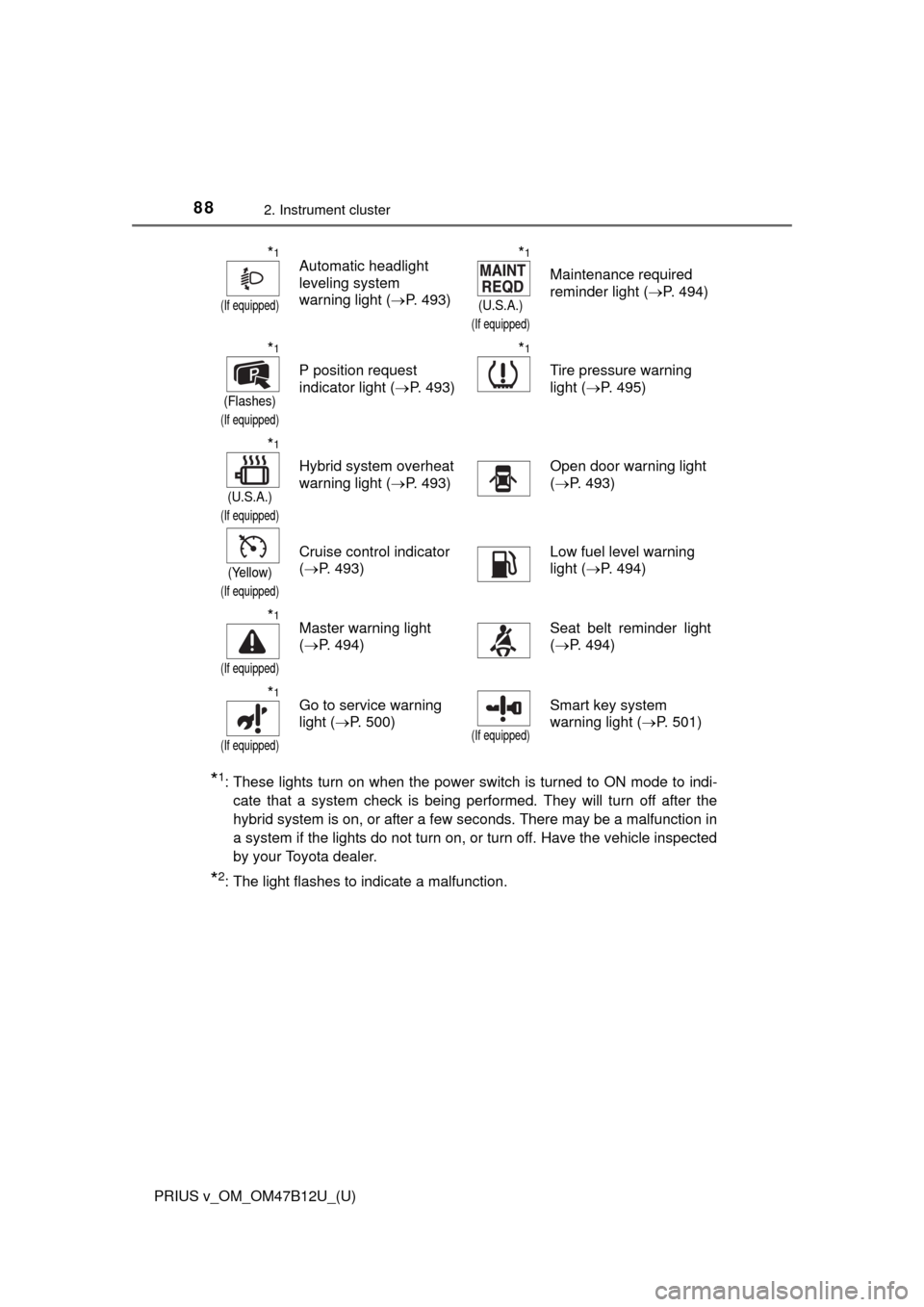
88
PRIUS v_OM_OM47B12U_(U)
2. Instrument cluster
*1: These lights turn on when the power switch is turned to ON mode to indi-
cate that a system check is being performed. They will turn off after the
hybrid system is on, or after a few seconds. There may be a malfunction in
a system if the lights do not turn on, or turn off. Have the vehicle inspected
by your Toyota dealer.
*2: The light flashes to indicate a malfunction.
*1
(If equipped)
Automatic headlight
leveling system
warning light (P. 493)*1
(U.S.A.)
(If equipped)
Maintenance required
reminder light (P. 494)
*1
(Flashes)
(If equipped)
P position request
indicator light (P. 493)
*1
Tire pressure warning
light (P. 495)
*1
(U.S.A.)
(If equipped)
Hybrid system overheat
warning light (P. 493)Open door warning light
(P. 493)
(Yellow)
(If equipped)
Cruise control indicator
(P. 493)Low fuel level warning
light (P. 494)
*1
(If equipped)
Master warning light
(P. 494)Seat belt reminder light
(P. 494)
*1
(If equipped)
Go to service warning
light (P. 500)
(If equipped)
Smart key system
warning light (P. 501)
Page 261 of 620

PRIUS v_OM_OM47B12U_(U)
2614-6. Driving tips
4
Driving
◆When braking
Make sure to operate the brakes gently and in a timely manner. A
greater amount of electrical energy can be regenerated when slow-
ing down.
◆Delays
Repeated acceleration and deceleration, as well as long waits at
traffic lights, will lead to bad fuel economy. Check traffic reports
before leaving and avoid delays as much as possible. When driving
in a traffic jam, gently release the brake pedal to allow the vehicle to
move forward slightly while avoiding overuse of the accelerator
pedal. Doing so can help control excessive gasoline consumption.
◆Highway driving
Control and maintain the vehicle at a constant speed. Before stop-
ping at a toll booth or similar, allow plenty of time to release the
accelerator and gently apply the brakes. A greater amount of elec-
trical energy can be regenerated when slowing down.
◆Air conditioning
Use the air conditioning only when necessary. Doing so can help
reduce excessive gasoline consumption.
In summer: When the ambient temperature is high, use the recircu-
lated air mode. Doing so will help to reduce the burden on the air
conditioning system and reduce fuel consumption as well.
In winter: Because the gasoline engine will not automatically cut out
until it and the interior of the vehicle are warm, it will consume fuel.
Fuel consumption can be improved by avoiding overuse of the
heater.
◆Checking tire inflation pressure
Make sure to check the tire inflation pressure frequently. Improper
tire inflation pressure can cause poor fuel economy.
Also, as snow tires can cause large amounts of friction, their use on
dry roads can lead to poor fuel economy. Use tires that are appro-
priate for the season.
Page 406 of 620
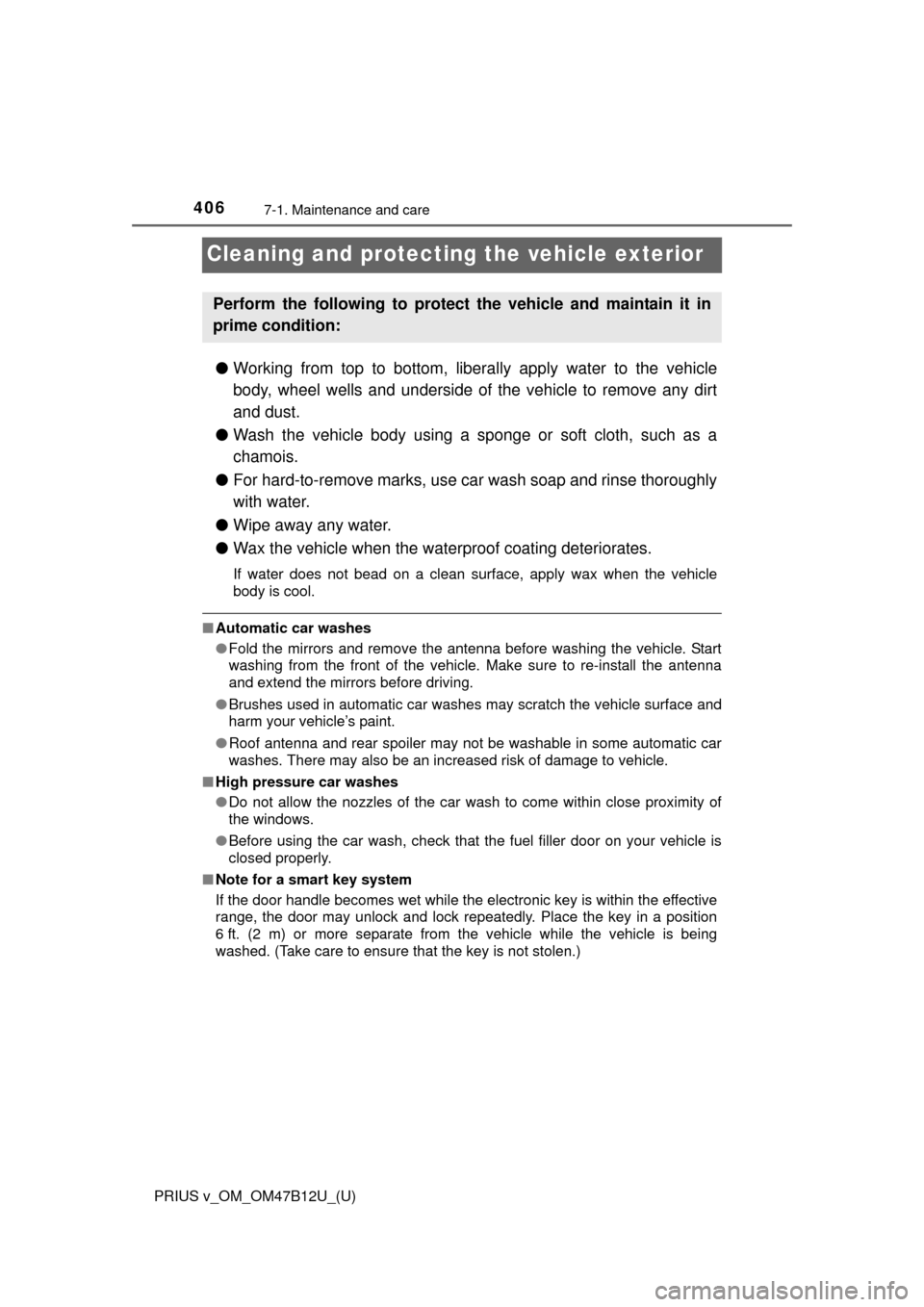
406
PRIUS v_OM_OM47B12U_(U)
7-1. Maintenance and care
Cleaning and protecting the vehicle exterior
●Working from top to bottom, liberally apply water to the vehicle
body, wheel wells and underside of the vehicle to remove any dirt
and dust.
●Wash the vehicle body using a sponge or soft cloth, such as a
chamois.
●For hard-to-remove marks, use car wash soap and rinse thoroughly
with water.
●Wipe away any water.
●Wax the vehicle when the waterproof coating deteriorates.
If water does not bead on a clean surface, apply wax when the vehicle
body is cool.
■Automatic car washes
●Fold the mirrors and remove the antenna before washing the vehicle. Start
washing from the front of the vehicle. Make sure to re-install the antenna
and extend the mirrors before driving.
●Brushes used in automatic car washes may scratch the vehicle surface and
harm your vehicle’s paint.
●Roof antenna and rear spoiler may not be washable in some automatic car
washes. There may also be an increased risk of damage to vehicle.
■High pressure car washes
●Do not allow the nozzles of the car wash to come within close proximity of
the windows.
●Before using the car wash, check that the fuel filler door on your vehicle is
closed properly.
■Note for a smart key system
If the door handle becomes wet while the electronic key is within the effective
range, the door may unlock and lock repeatedly. Place the key in a position
6 ft. (2 m) or more separate from the vehicle while the vehicle is being
washed. (Take care to ensure that the key is not stolen.)
Perform the following to protect the vehicle and maintain it in
prime condition:
Page 453 of 620
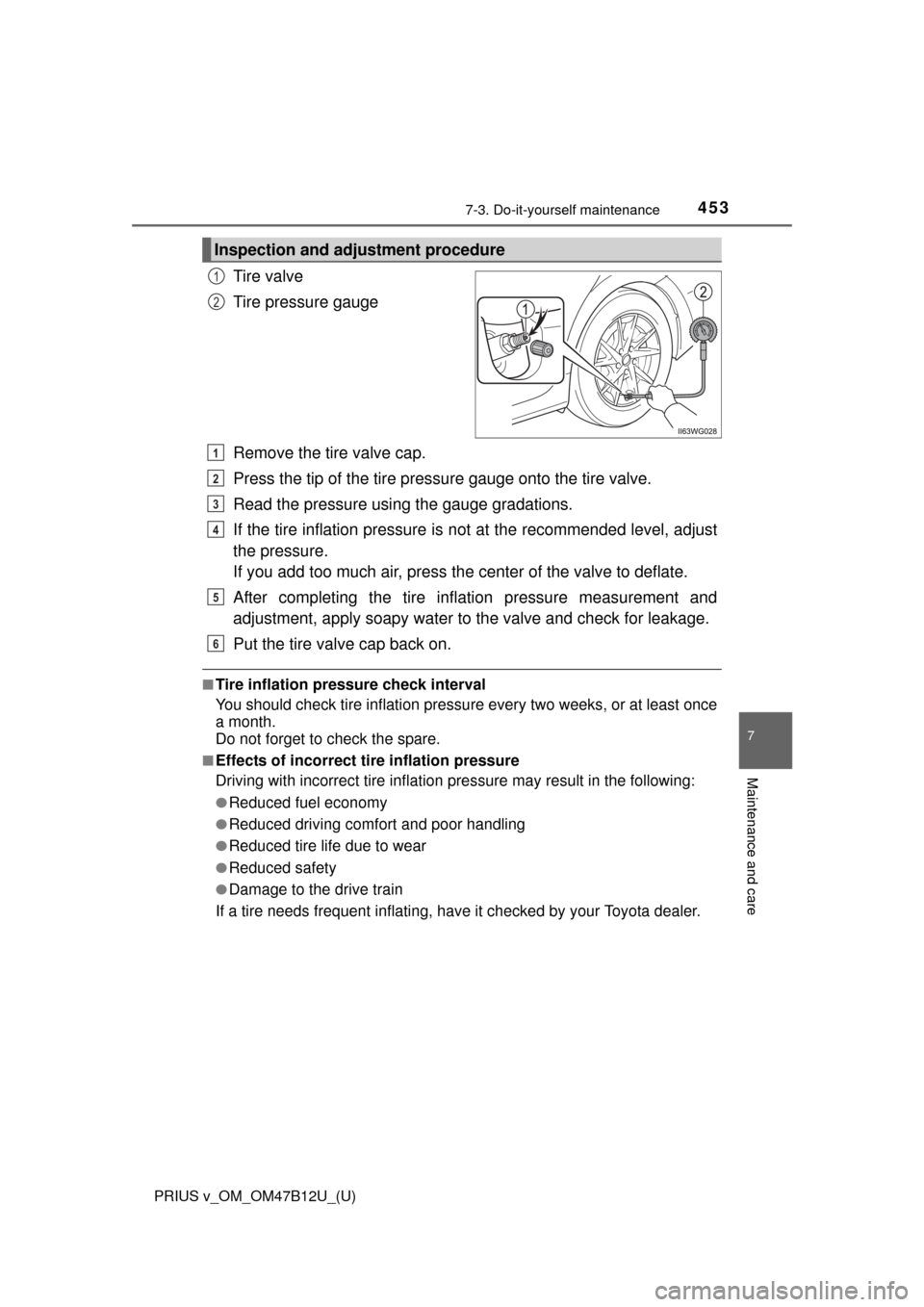
PRIUS v_OM_OM47B12U_(U)
4537-3. Do-it-yourself maintenance
7
Maintenance and care
Tire valve
Tire pressure gauge
Remove the tire valve cap.
Press the tip of the tire pressure gauge onto the tire valve.
Read the pressure using the gauge gradations.
If the tire inflation pressure is not at the recommended level, adjust
the pressure.
If you add too much air, press the center of the valve to deflate.
After completing the tire inflation pressure measurement and
adjustment, apply soapy water to the valve and check for leakage.
Put the tire valve cap back on.
■Tire inflation pressure check interval
You should check tire inflation pressure every two weeks, or at least once
a month.
Do not forget to check the spare.
■Effects of incorrect tire inflation pressure
Driving with incorrect tire inflation pressure may result in the following:
●Reduced fuel economy
●Reduced driving comfort and poor handling
●Reduced tire life due to wear
●Reduced safety
●Damage to the drive train
If a tire needs frequent inflating, have it checked by your Toyota dealer.
Inspection and adjustment procedure
1
2
1
2
3
4
5
6
Page 499 of 620
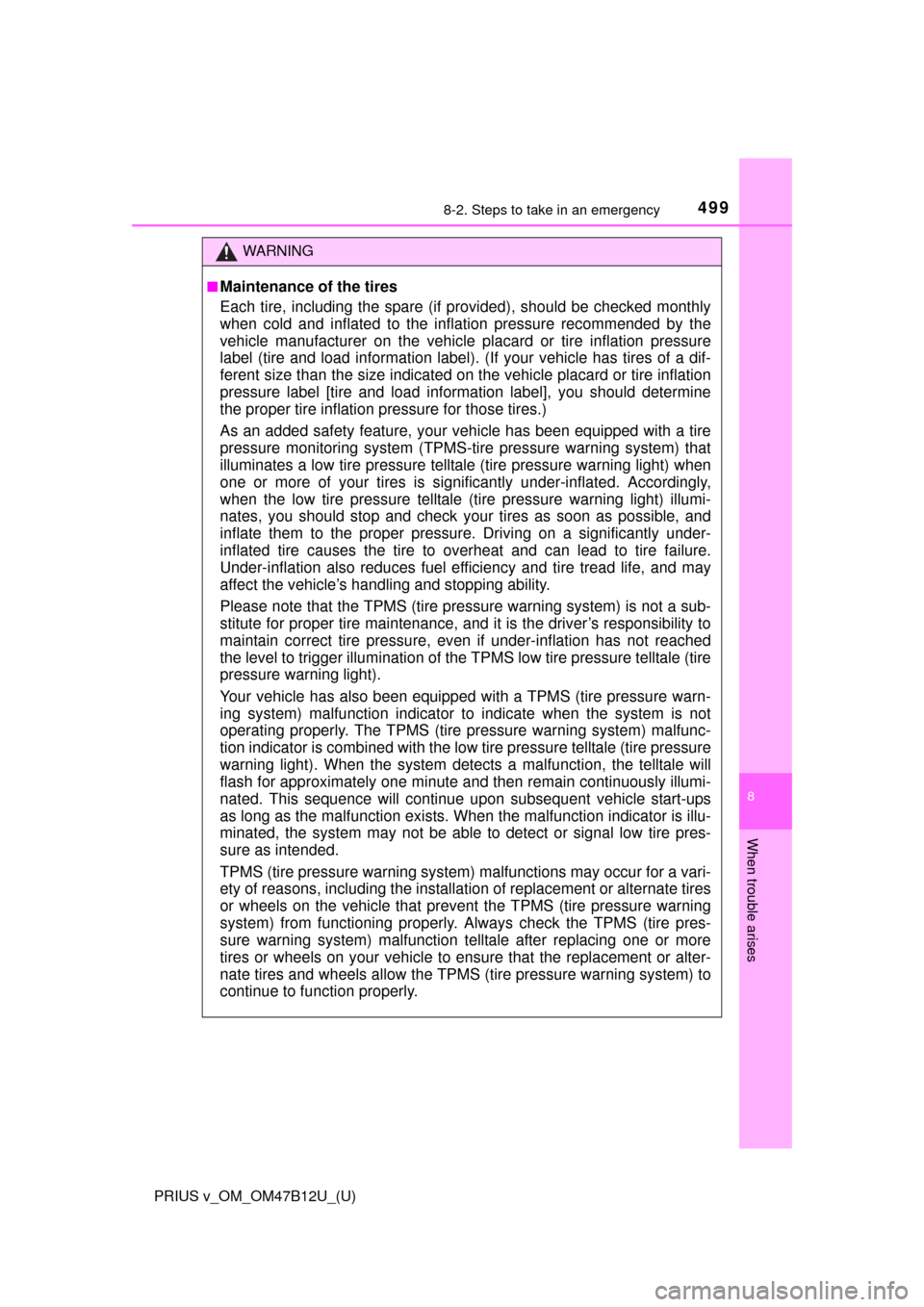
4998-2. Steps to take in an emergency
PRIUS v_OM_OM47B12U_(U)
8
When trouble arises
WARNING
■Maintenance of the tires
Each tire, including the spare (if provided), should be checked monthly
when cold and inflated to the inflation pressure recommended by the
vehicle manufacturer on the vehicle placard or tire inflation pressure
label (tire and load information label). (If your vehicle has tires of a dif-
ferent size than the size indicated on the vehicle placard or tire inflation
pressure label [tire and load information label], you should determine
the proper tire inflation pressure for those tires.)
As an added safety feature, your vehicle has been equipped with a tire
pressure monitoring system (TPMS-tire pressure warning system) that
illuminates a low tire pressure telltale (tire pressure warning light) when
one or more of your tires is significantly under-inflated. Accordingly,
when the low tire pressure telltale (tire pressure warning light) illumi-
nates, you should stop and check your tires as soon as possible, and
inflate them to the proper pressure. Driving on a significantly under-
inflated tire causes the tire to overheat and can lead to tire failure.
Under-inflation also reduces fuel efficiency and tire tread life, and may
affect the vehicle’s handling and stopping ability.
Please note that the TPMS (tire pressure warning system) is not a sub-
stitute for proper tire maintenance, and it is the driver’s responsibility to
maintain correct tire pressure, even if under-inflation has not reached
the level to trigger illumination of the TPMS low tire pressure telltale (tire
pressure warning light).
Your vehicle has also been equipped with a TPMS (tire pressure warn-
ing system) malfunction indicator to indicate when the system is not
operating properly. The TPMS (tire pressure warning system) malfunc-
tion indicator is combined with the low tire pressure telltale (tire pressure
warning light). When the system detects a malfunction, the telltale will
flash for approximately one minute and then remain continuously illumi-
nated. This sequence will continue upon subsequent vehicle start-ups
as long as the malfunction exists. When the malfunction indicator is illu-
minated, the system may not be able to detect or signal low tire pres-
sure as intended.
TPMS (tire pressure warning system) malfunctions may occur for a vari-
ety of reasons, including the installation of replacement or alternate tires
or wheels on the vehicle that prevent the TPMS (tire pressure warning
system) from functioning properly. Always check the TPMS (tire pres-
sure warning system) malfunction telltale after replacing one or more
tires or wheels on your vehicle to ensure that the replacement or alter-
nate tires and wheels allow the TPMS (tire pressure warning system) to
continue to function properly.
Page 569 of 620
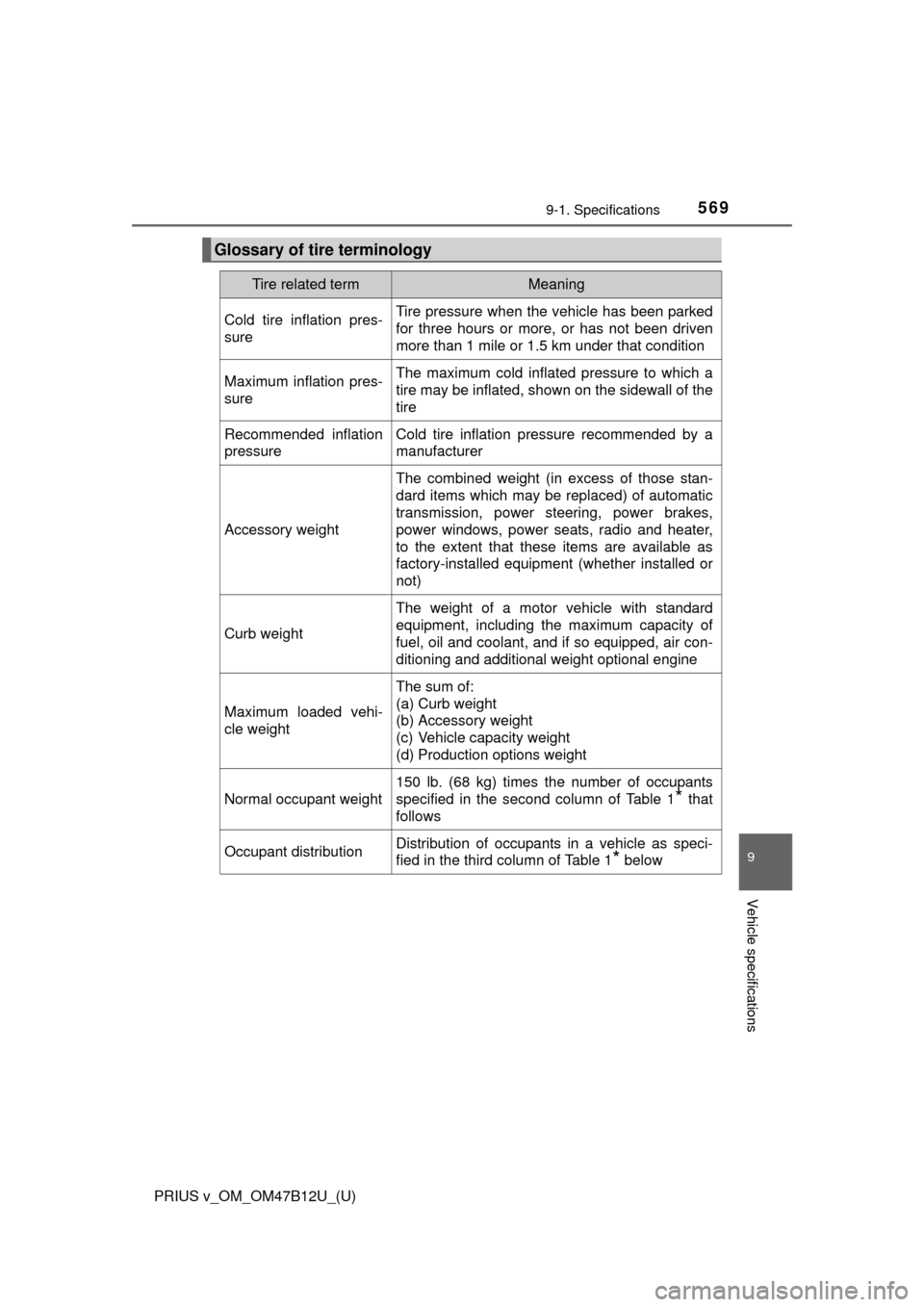
PRIUS v_OM_OM47B12U_(U)
5699-1. Specifications
9
Vehicle specifications
Glossary of tire terminology
Tire related termMeaning
Cold tire inflation pres-
sureTire pressure when the vehicle has been parked
for three hours or more, or has not been driven
more than 1 mile or 1.5 km under that condition
Maximum inflation pres-
sureThe maximum cold inflated pressure to which a
tire may be inflated, shown on the sidewall of the
tire
Recommended inflation
pressureCold tire inflation pressure recommended by a
manufacturer
Accessory weight
The combined weight (in excess of those stan-
dard items which may be replaced) of automatic
transmission, power steering, power brakes,
power windows, power seats, radio and heater,
to the extent that these items are available as
factory-installed equipment (whether installed or
not)
Curb weight
The weight of a motor vehicle with standard
equipment, including the maximum capacity of
fuel, oil and coolant, and if so equipped, air con-
ditioning and additional weight optional engine
Maximum loaded vehi-
cle weight
The sum of:
(a) Curb weight
(b) Accessory weight
(c) Vehicle capacity weight
(d) Production options weight
Normal occupant weight
150 lb. (68 kg) times the number of occupants
specified in the second column of Table 1
* that
follows
Occupant distributionDistribution of occupants in a vehicle as speci-
fied in the third column of Table 1
* below
Page 618 of 620
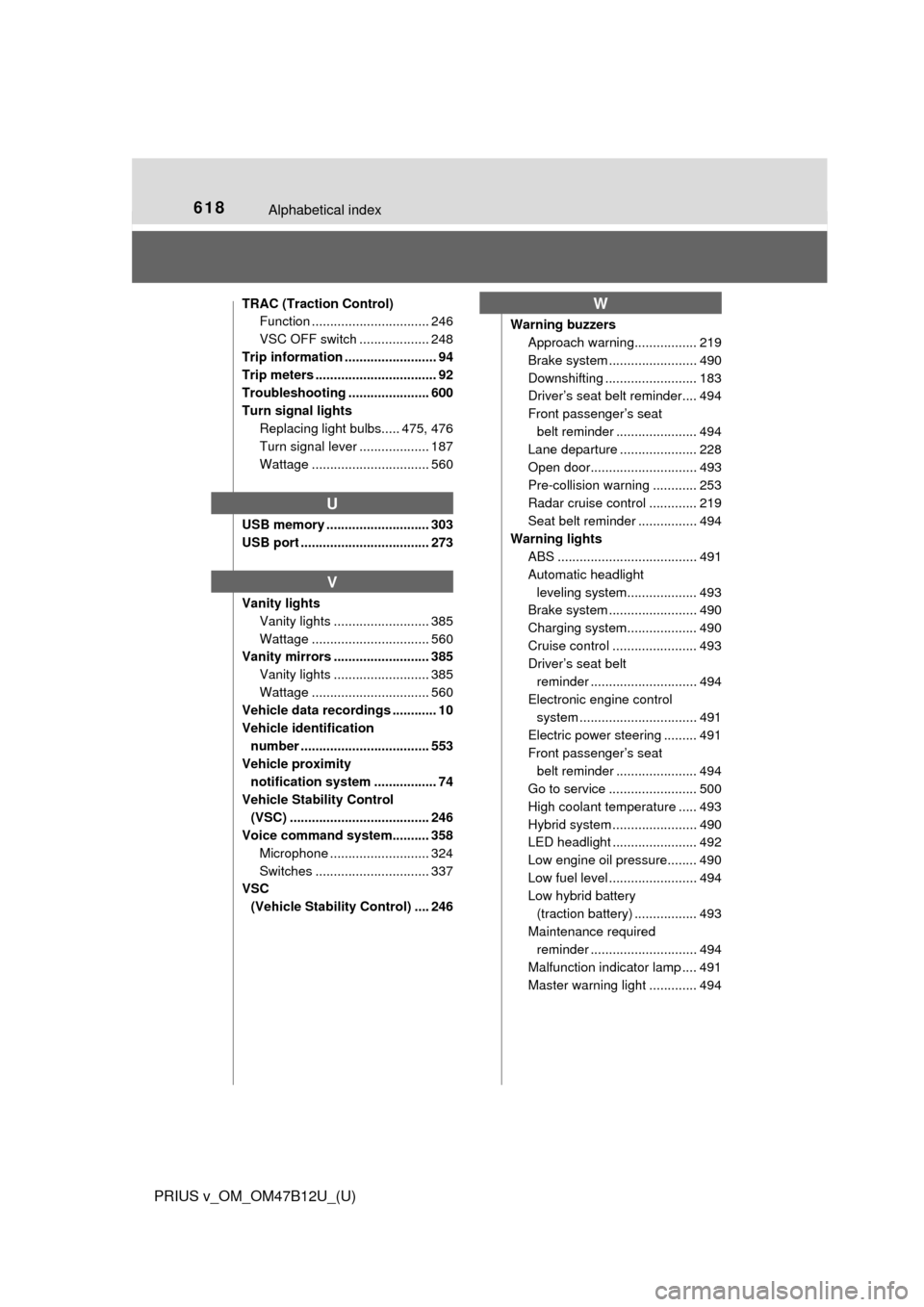
618Alphabetical index
PRIUS v_OM_OM47B12U_(U)
TRAC (Traction Control)
Function ................................ 246
VSC OFF switch ................... 248
Trip information ......................... 94
Trip meters ................................. 92
Troubleshooting ...................... 600
Turn signal lights
Replacing light bulbs..... 475, 476
Turn signal lever ................... 187
Wattage ................................ 560
USB memory ............................ 303
USB port ................................... 273
Vanity lights
Vanity lights .......................... 385
Wattage ................................ 560
Vanity mirrors .......................... 385
Vanity lights .......................... 385
Wattage ................................ 560
Vehicle data recordings ............ 10
Vehicle identification
number ................................... 553
Vehicle proximity
notification system ................. 74
Vehicle Stability Control
(VSC) ...................................... 246
Voice command system.......... 358
Microphone ........................... 324
Switches ............................... 337
VSC
(Vehicle Stability Control) .... 246Warning buzzers
Approach warning................. 219
Brake system ........................ 490
Downshifting ......................... 183
Driver’s seat belt reminder.... 494
Front passenger’s seat
belt reminder ...................... 494
Lane departure ..................... 228
Open door............................. 493
Pre-collision warning ............ 253
Radar cruise control ............. 219
Seat belt reminder ................ 494
Warning lights
ABS ...................................... 491
Automatic headlight
leveling system................... 493
Brake system ........................ 490
Charging system................... 490
Cruise control ....................... 493
Driver’s seat belt
reminder ............................. 494
Electronic engine control
system ................................ 491
Electric power steering ......... 491
Front passenger’s seat
belt reminder ...................... 494
Go to service ........................ 500
High coolant temperature ..... 493
Hybrid system ....................... 490
LED headlight ....................... 492
Low engine oil pressure........ 490
Low fuel level ........................ 494
Low hybrid battery
(traction battery) ................. 493
Maintenance required
reminder ............................. 494
Malfunction indicator lamp .... 491
Master warning light ............. 494
U
V
W